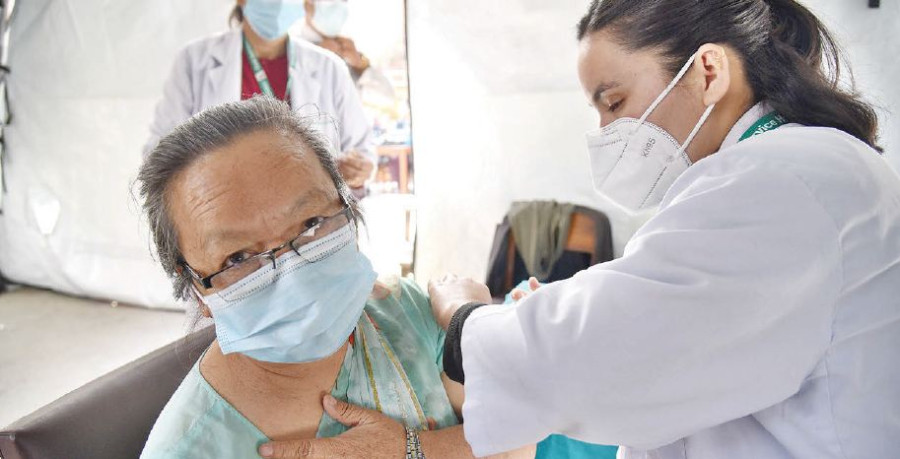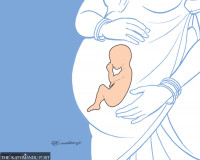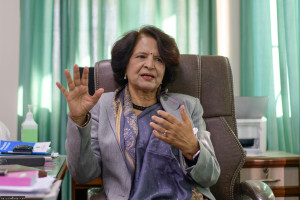Health
Nepal likely to receive 1.5 million doses of J&J jab from COVAX
The first single shot vaccine against Covid-19 is expected within two weeks and officials say they have been planning to administer all the shots within July.
Arjun Poudel
If everything goes as planned, Nepal is most likely to get 1.5 million doses of the Johnson & Johnson Covid-19 vaccine next week under the COVAX facility, multiple officials at the Ministry of Health and Population confirmed.
COVAX, the international vaccine-sharing scheme backed by the United Nations, which has committed to providing 13 million doses of Covid-19 vaccine, sufficient to inoculate 20 percent of the 30 million population, has proposed the authorities to accept the single-shot Johnson & Johnson vaccine.
“We have agreed to take the Johnson & Johnson vaccine from COVAX,” Dr Tara Nath Pokhrel, director at the Family Welfare Division under the Department of Health Services, told the Post. “The vaccine will most probably arrive by the end of next week.”
Johnson & Johnson Covid-19 vaccine is the first single shot vaccine listed by the World Health Organisation for emergency use in all countries and for COVAX roll-out. The UN health agency approved it on March 12.
The European Medicines Agency (EMA) has also granted emergency use authorisation for the vaccine. From the logistical point of view also, the vaccine is suitable for Nepal, as it can be stored in 2 to 8 degrees Celsius for three months.
“Only the shipment procedure remains to be finalised,” said Pokhrel. “Once the shipment procedure is finalised, the vaccines will arrive.”
Nepal so far has used just two types of Covid-19 vaccines to inoculate its population–Covishield, the AstraZeneca type vaccine manufactured by the Serum Institute of India, and Vero Cell, which is developed and manufactured by China’s state-owned pharmaceutical company Sinopharm.
According to Pokhrel, the Health Ministry has directed its subordinate agencies to make plans to administer the vaccine at the earliest, as more vaccines are coming from China and COVAX in coming days.
Nepal had in the third week of April reached out to Johnson & Johnson to buy
5 million doses of the vaccine. The manufacturing company, however, ruled out the possibility of selling the shots to Nepal before 2022 citing supply chain constraints and other reasons.
“We couldn't buy the vaccine directly with the manufacturing company, but this vaccine is coming to us through COVAX,” an official at the Ministry of Health told the Post, requesting anonymity. “A few weeks ago, the COVAX facility had proposed to provide 600,000 doses, but did not send them; this time they have committed to providing 1.5 million doses.”
After COVAX itself started facing a crisis, as India put a hold on exports of Covishield, it had in March communicated to Nepal about delays and asked to choose vaccines other than AstraZeneca.
That the 1.5 million doses of J&J are likely to arrive in Nepal is a new development, which comes as a respite for a country which is struggling to acquire the jabs.
The World Health Organisation’s Nepal office, however, did not immediately confirm that Nepal has been assured of 1.5 million doses of the vaccine manufactured by the American company.
Earlier on March 7, the facility had provided 348,000 doses of Covishield vaccine manufactured by the Serum Institute of India.
COVAX has also committed to providing additional 348,000 doses of AstraZeneca vaccine by July 22. Nepal is desperately waiting for the AstraZeneca vaccine to give second doses to about 1.4 million people aged 65 and above who took their first shots in March.
“The Johnson & Johnson doses will be a huge relief to Nepal, as it is a single-shot vaccine which is reported to have generated strong immunity against the fast spreading Delta variant of the coronavirus,” Dr Shyam Raj Upreti, coordinator of the Covid-19 Vaccine Advisory Committee, told the Post. “Authorities concerned should be prepared to administer the shots at the earliest.”
Data released by Johnson & Johnson on July 1 demonstrated “strong, persistent activity against the rapidly spreading Delta variant and other highly prevalent SARS-CoV-2 viral variants”.
“Today’s newly announced studies reinforce the ability of the Johnson & Johnson Covid-19 vaccine to help protect the health of people globally,” the company said on its website, quoting Paul Stoffels, its vice chairman of the executive committee and chief scientific officer. “We believe that our vaccine offers durable protection against COVID-19 and elicits neutralizing activity against the Delta variant. This adds to the robust body of clinical data supporting our single-shot vaccine’s ability to protect against multiple variants of concern.”
The American vaccine is set to arrive in Nepal at a time when 4 million doses of Vero Cell, the Chinese vaccine, are being brought in starting Thursday.
A Nepal Airlines aircraft is set to fly to Beijing on Thursday, which will bring around 1 million doses of the Sinopharm vaccine in the first consignment. Flights are also scheduled for July 15 and July 22, each of which is expected to bring 1 million doses, according to Health Ministry officials.
Nepal is buying 4 million doses of Sinopharm vaccine under a non-disclosure agreement.
Public health as well as immunisation experts are concerned about sufficient vaccine storage and management capacity of Nepali authorities as well as communication strategy.
The acceptance rate of the Chinese vaccine, when China provided 800,000 doses as a grant in March, was low and it was not clear who was eligible for them. But after the second wave of the pandemic hit the country, infecting hundreds of thousands of people and killing over 6,000, there is an urgency to inoculate as many people at the earliest.
The government has decided to inoculate 72 percent of the 30 million population, as 28 percent are under 14 years of age.
According to the Health Ministry, 2,606,005 people have so far received their first doses and of them 758,046 have been given both doses.
Kathmandu Valley residents aged 60 to 64 years and others aged 62 to 64 will get the second doses of the Sinopharm vaccine from Tuesday with the 1 million doses that China provided last month under grant assistance. Earlier in March, Nepal had received 800,000 doses of Vero Cell under Chinese grant.
Authorities have planned to inoculate those above the age of 55 with the new lot of the Chinese vaccine that will start arriving later this week.
Nepal launched its vaccination drive on January 27 with one million doses of Covishield that India had provided under grant assistance. Of the 2 million doses of Covishield that Nepal bought from the Serum Institute, only half was delivered.
With the number of cases continuing to rise and authorities relaxing prohibitory orders that were imposed on April 29, experts have highlighted the urgency to immunise as many people as possible.
“Agencies concerned should start preparation to administer vaccines at the earliest,” Dr Bhagwan Koirala, chairman of the Nepal Medical Council, the national regulatory body of medical doctors, told the Post. “People should also get the vaccine at the earliest opportunity available. Nobody is safe until everybody is safe.”
With the lifting of restrictions, the risk of spread of infections in communities has increased, public health experts say.
As the positivity rate is still very high, death rate is significant and new cases have been reported from across the country, they said that the country could soon witness another wave.
“For countries like ours, vaccines are the best means to contain the spread of infection and lessen loss,” Dr Janak Koirala, an infectious disease expert, told the Post. “Authorities should also pay attention towards the growing risk of spread of infection in the aftermath of the lifting of restrictions. While focussing on vaccination, we should not forget the importance of the safety measures.”




 5.47°C Kathmandu
5.47°C Kathmandu














